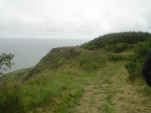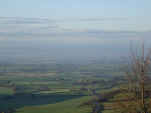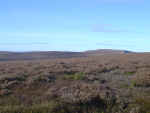

|
 The North York Moors may not be one of the best known national parks, but the area includes some breathtakingly beautiful scenery, including vast expanses of open moorland, dramatic sea cliffs, sudden escarpments and hidden valleys.
The North York Moors may not be one of the best known national parks, but the area includes some breathtakingly beautiful scenery, including vast expanses of open moorland, dramatic sea cliffs, sudden escarpments and hidden valleys.
 This site is going to be my personal guide to the Yorkshire Moors, based on twenty years of walking in the national park. We will be building up a collection of suggested walks (fifty two at the moment), complete with maps and easy to follow instructions, each based on my own walks over the last few years, and illustrated by some of the thousands of photos I've taken on the moors.
This site is going to be my personal guide to the Yorkshire Moors, based on twenty years of walking in the national park. We will be building up a collection of suggested walks (fifty two at the moment), complete with maps and easy to follow instructions, each based on my own walks over the last few years, and illustrated by some of the thousands of photos I've taken on the moors.
 The heart of the site is going to be the gazetteer,
which we hope to develop into a complete guide to the Yorkshire Moors, supported by a series of maps created for this site.
Gazetteer entries will be created as I visit the Moors, and expanded as more information is found, so keep coming back.
We also hope to create a series of articles about the wildlife and history of the moors.
The heart of the site is going to be the gazetteer,
which we hope to develop into a complete guide to the Yorkshire Moors, supported by a series of maps created for this site.
Gazetteer entries will be created as I visit the Moors, and expanded as more information is found, so keep coming back.
We also hope to create a series of articles about the wildlife and history of the moors.
If you have any questions, then get in touch using our contact form and we'll get back to you as soon as possible.
Most recent addition: 12 November 2016: The chapel of St. John the Baptist at East Ayton is an attractive low-built medieval church, built of golden stone with a red tiled roof
At the end of July 2006 I walked Hadrian's Wall for the Perthes Disease Association.
Click on the map below to go to more detailed maps of the Moors, linked to our gazatteer.

28 May 2016: Rye Dale is the main valley in the south-western corner of the North York Moors, running from the high moors east of Osmotherley, through some very remove country and past the historic remains of Revieux Abbey, before leaving the Moors at Helmsley.
17 April 2016: Westerdale is an enclosed valley that sits at the head of Esk Dale, with some of the highest land in the North York Moors surrounding the head of the dale.
12 March 2016: Shunner Howe is a well preserved Bronze Age round barrow that later served as a lookout point and then as a parish boundary,
10 January 2016: Esk Dale is the largest dale within the North York Moors, and the only one of the major valleys that flows directly into the sea, reaching the North Sea at Whitby.
13 December 2015: Danby Dale is one of a series of valleys that flow north into the Esk, creating a pattern of valleys and ridges that give the area its distinctive character
Older Updates
Copyright John Rickard, 2005-2009